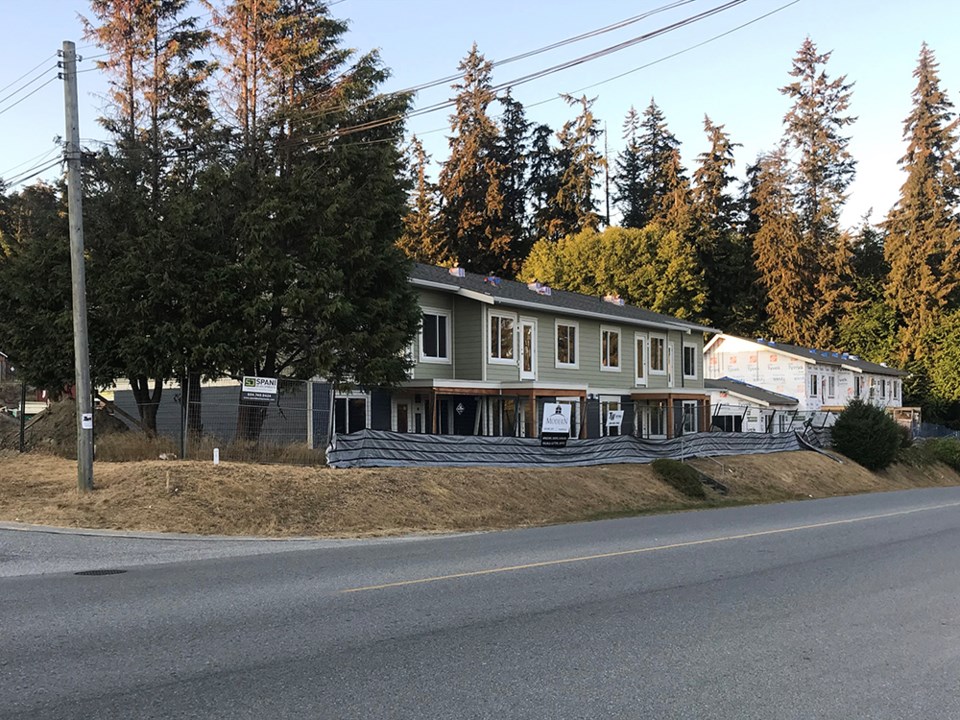City of Powell River councillors have amended a proposed development variance permit for Life Cycle Housing Society’s Cranberry Place development to require a sidewalk.
At the August 30 committee of the whole meeting, councillors, by a four to three margin, voted to issue notice to not require sidewalk construction, and relax the paved road requirement from 12 to 10.5 metres. However, at the September 1 city council meeting, mayor Dave Formosa brought the matter back before councillors, believing the original vote was misunderstood by at least one member.
Formosa said he and councillors Rob Southcott and Jim Palm had met with the engineering department and chief administrative officer.
“I wanted to understand what was happening,” added Formosa. “Life Cycle Housing has asked that we waive the sidewalk and the width of the road. I understood that some of us had a problem with waiving the sidewalk.
“I thought there were two folks who did not understand, who felt rushed, and voted wrong.”
The mayor said, however, that it appears one had some misunderstandings about the initiative.
Formosa said he thought it would be prudent to review the options again.
Corporate officer Chris Jackson said two out of the three options regarding the variance presented by staff require the city to provide public notice. The first option was for no sidewalk requirement or road expansion, the second option was sending out public notice saying the housing society would need to construct a sidewalk and not expand the road, with $50,000 in support funding from the city, and the third was for no variance.
Councillor CaroleAnn Leishman said her hope was to go to the neighbourhood and find out what they think about a “sidewalk to nowhere.” She said there were challenges with the water main in that location, plus a gas line, and that engineering might reveal that it is going to crush the water main or hit the gas line.
Councillor Rob Southcott said that following the August 30 meeting, he realized what he had supported wasn’t what he would have supported if he had understood the motion. He said he supports accessibility, the sidewalk and the proposed grant, and does not support the motion passed at committee of the whole.
Councillor Cindy Elliott said her hope for the project is that an accessibility plan for people in wheelchairs to get to the park is submitted. If approving the full variance means developers can go ahead without accessibility, she would not be in favour of it, she added.
Life Cycle president Frances Ladret said it was the society’s understanding that city staff did not want a sidewalk in front of the development.
“We didn’t think we had to provide a bunch of information,” added Ladret.
She said the project team had met after the committee vote to get firm costs, plus information from a contractor on the risks involved, and look at providing accessibility on Dieppe Crescent.
“Our intention was to get that information and get it to you before the council meeting on September 22, at which time you might feel more comfortable with the recommendation you passed at committee,” said Ladret.
She said if council passed the recommendation to require the sidewalk, and the public is notified, if the society comes back with information that is persuasive that this is not a good idea to put the sidewalk in, now, the city is going to have to have a different motion and take it to the public, and that will delay the project further.
Motion defeated
On the motion to allow the variance for the sidewalk and roadway, three councillors voted for it and four were against, so the motion was defeated.
Councillor George Doubt then brought forward a motion that staff be directed to give notice of council’s intention to consider issuance of a development variance permit by relaxing the requirement for minimum pavement width, and approving allocation of $50,000 to Life Cycle to contribute to costs of constructing a sidewalk on Cranberry Street.
“That accomplishes what everyone around the table wants,” said Doubt. “It will give notice, it will get the public coming here to make comments on whether they like that or not, and council can hopefully hear more from the city’s engineering staff and the proponent, and move forward without too much further delay.”
Elliott said her concern with the motion was the proponent hasn’t been given a chance to negotiate.
“We may be moving a motion that is completely unhelpful to the proponent,” said Elliott.
Southcott said he supported accessibility and the principle of providing some funding for the society and its project, and putting the question to the neighbourhood.
Formosa said the proponent had to expend some effort, and the city was considering giving them some funds, to determine whether the sidewalk can be built.
Council carried the motion for the consideration of a sidewalk, and no road modifications, with Elliott and Leishman opposed.



